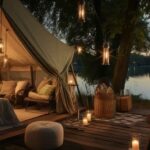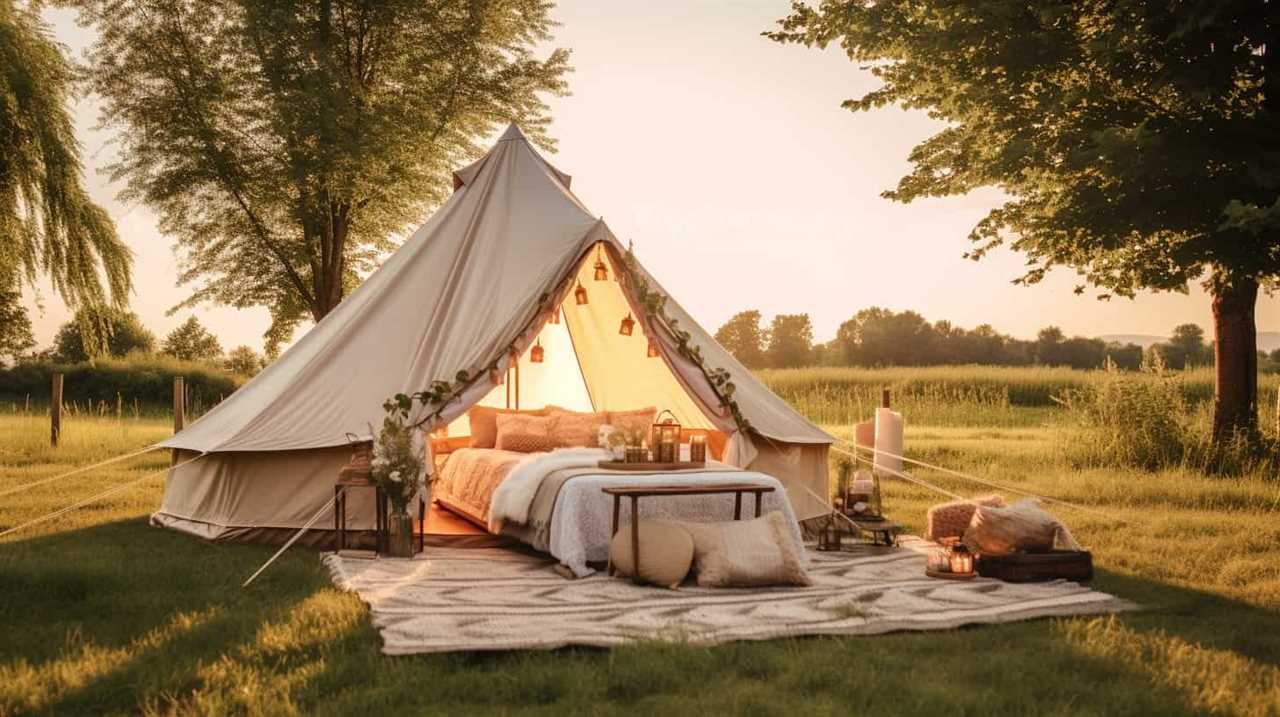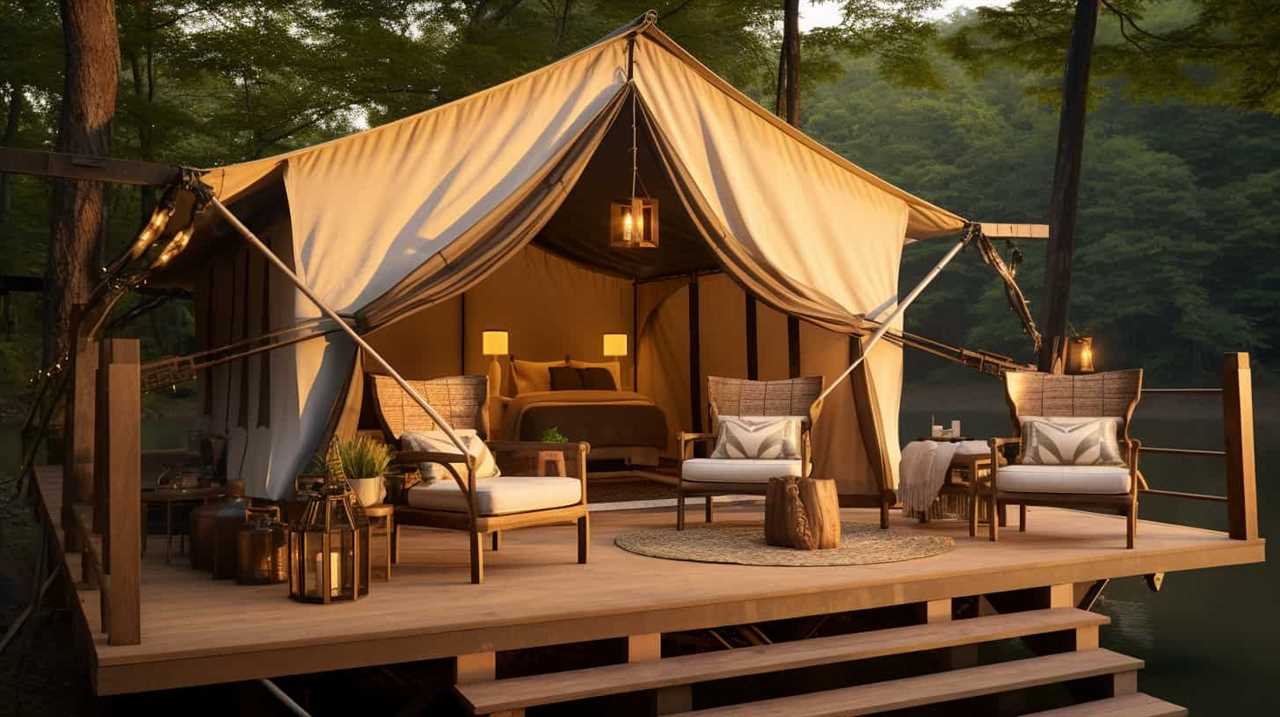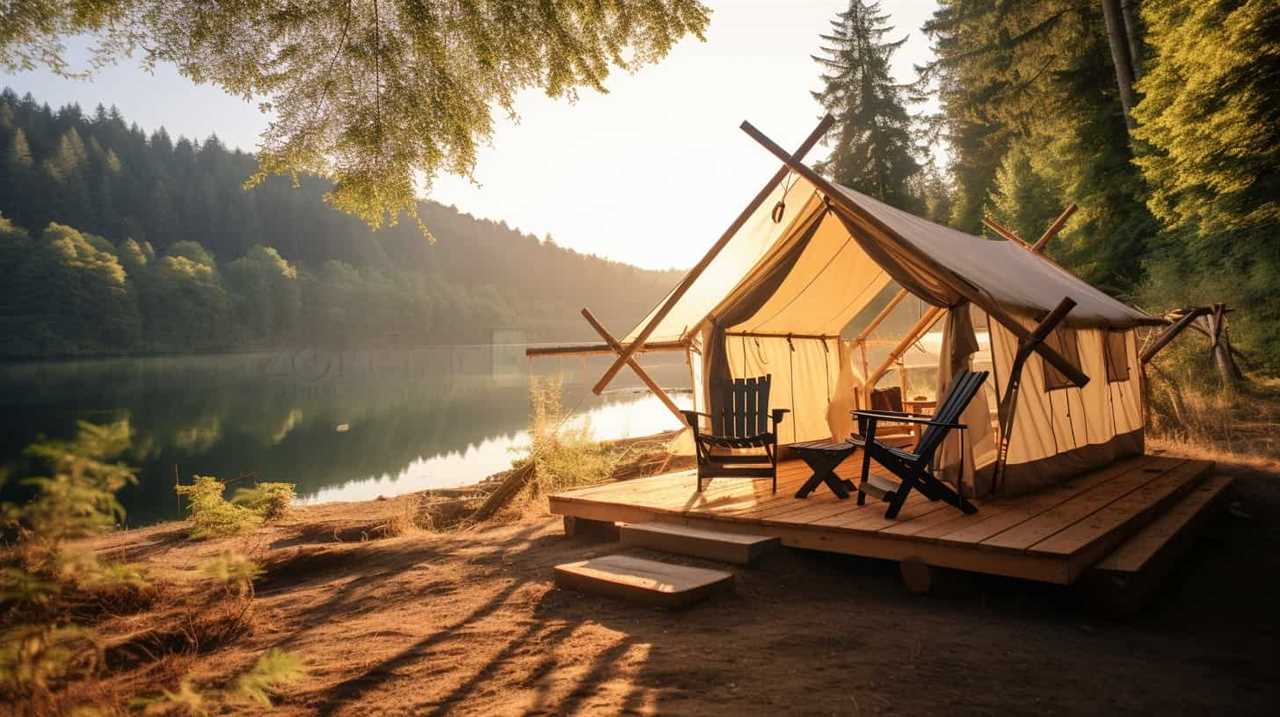Are you searching for a high-end outdoor adventure that prioritizes environmental conservation? Look no further, we’ve got you covered!
In this article, we’ll explore the best practices for eco-friendly glamping. Imagine waking up in a cozy, solar-powered cabin nestled in the heart of nature, surrounded by breathtaking views.
By embracing sustainable accommodations, mindful packing, and responsible waste management, you can enjoy the beauty of nature while minimizing your ecological footprint.
Let’s embark on this journey together!
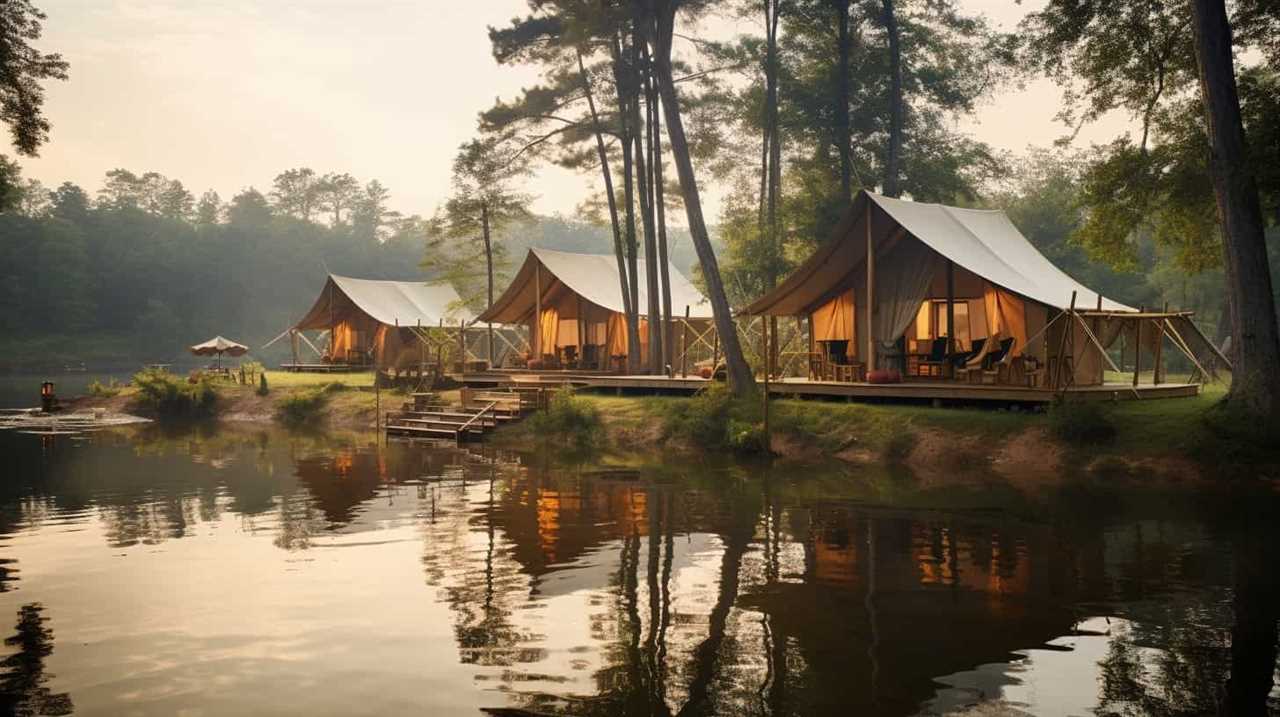
Key Takeaways
- Choose accommodations that prioritize sustainability and minimize environmental impact
- Practice responsible waste management through recycling and composting initiatives
- Embrace renewable energy sources such as solar panels and wind turbines
- Support local communities and engage in eco-friendly activities during the glamping experience
Choosing Eco-Friendly Accommodations
When selecting eco-friendly accommodations for a glamping experience, we should prioritize those that minimize our environmental impact. Mindful purchasing is essential in this process, as it allows us to support businesses that prioritize sustainability. Look for accommodations that source products and materials responsibly, such as using organic bedding and towels made from sustainable fibers.
Additionally, consider the construction of the accommodations itself. Choose structures that are built using eco-friendly construction methods, such as using reclaimed or recycled materials and incorporating energy-efficient features. By opting for accommodations that prioritize mindful purchasing and eco-friendly construction, we can reduce our ecological footprint while enjoying a luxurious glamping experience.
Now that we’ve chosen our eco-friendly accommodations, let’s move on to the next step: mindful packing for sustainable glamping.
Mindful Packing for Sustainable Glamping
Now that we’ve chosen our eco-friendly accommodations, let’s continue our sustainable glamping journey by discussing mindful packing.
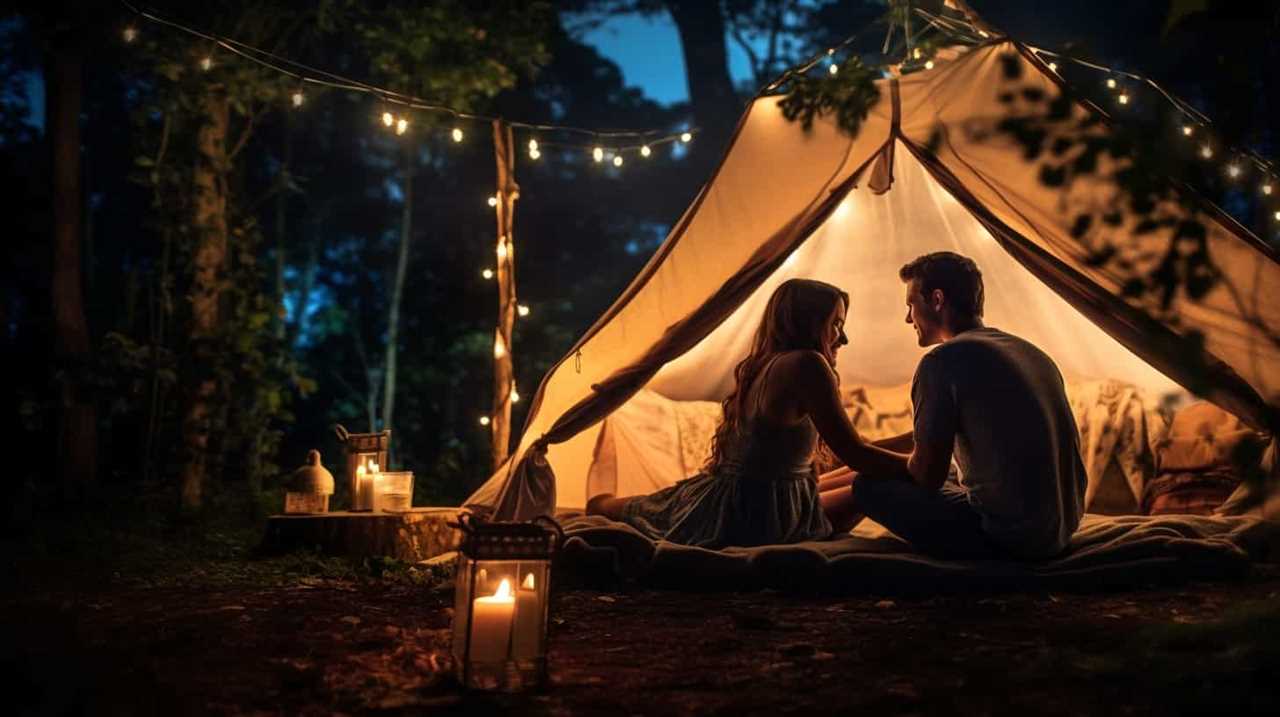
When it comes to sustainable glamping, it’s important to pack consciously and minimize our environmental impact. One way to do this is by choosing sustainable clothing made from organic or recycled materials. Look for brands that prioritize ethical production practices and fair trade.
Additionally, opt for eco-friendly toiletries such as biodegradable soaps, shampoos, and toothpaste. These products aren’t only better for the environment, but also for your own well-being. Remember to pack reusable water bottles, food containers, and utensils to minimize single-use plastic waste during your glamping adventure.
By packing mindfully, we can ensure that our impact on the environment is as minimal as possible.
As we move forward, let’s now explore responsible waste management at glamping sites.
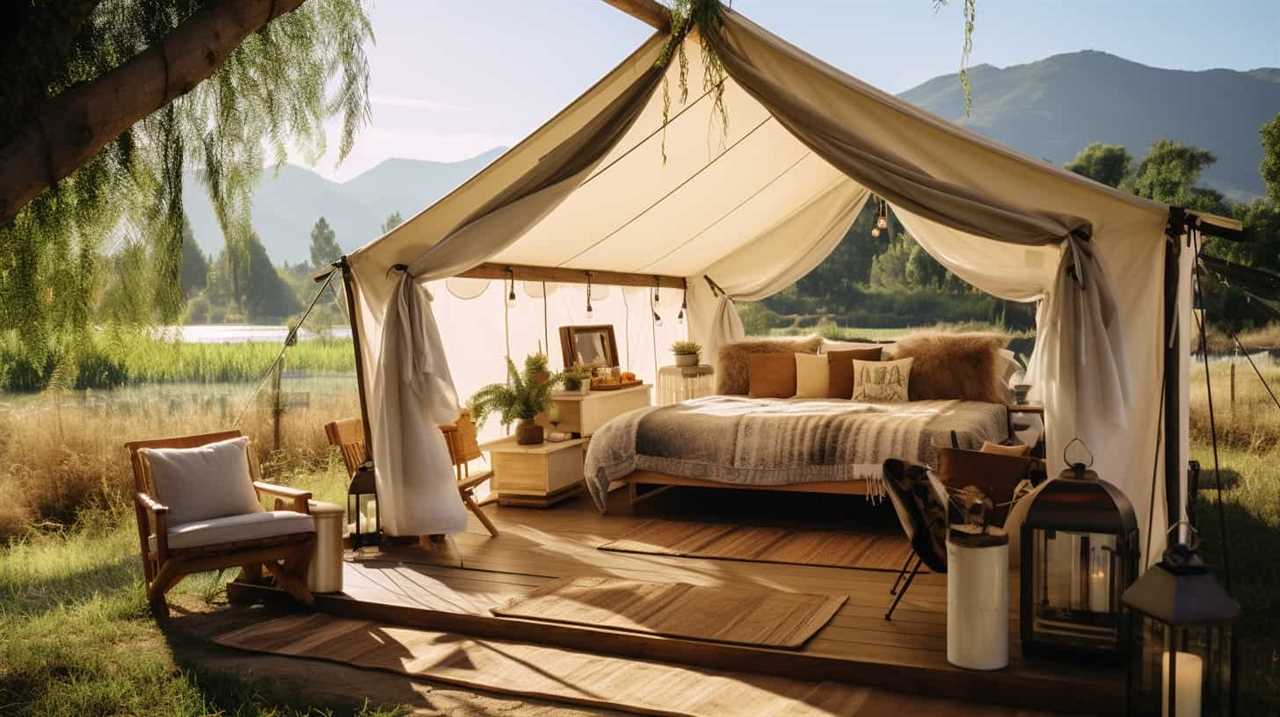
Responsible Waste Management at Glamping Sites
To ensure minimal environmental impact, it’s crucial that we practice responsible waste management at glamping sites. By implementing composting toilets and recycling initiatives, we can significantly reduce the amount of waste that ends up in landfills.
Here are some practical ways to manage waste responsibly:
- Composting toilets: These eco-friendly toilets use natural processes to break down waste into nutrient-rich compost. By using composting toilets, we can avoid polluting water sources and contribute to sustainable agriculture.
- Recycling initiatives: Setting up recycling stations throughout the glamping site encourages guests to separate their waste properly. Clearly labeled bins for different types of materials, such as plastic, glass, and paper, make recycling effortless and convenient.
- Educational signage: Placing informative signs near waste disposal areas can educate guests about the importance of responsible waste management. These signs can provide guidance on how to use composting toilets correctly and remind guests to recycle whenever possible.
Embracing Renewable Energy Sources
When it comes to embracing renewable energy sources in glamping sites, solar power is a popular and practical option. Installing solar panels can provide a sustainable and reliable source of electricity for lighting, heating, and charging devices.
Additionally, exploring wind energy options, such as small wind turbines, can further enhance the eco-friendly nature of glamping sites by harnessing the power of the wind to generate electricity.
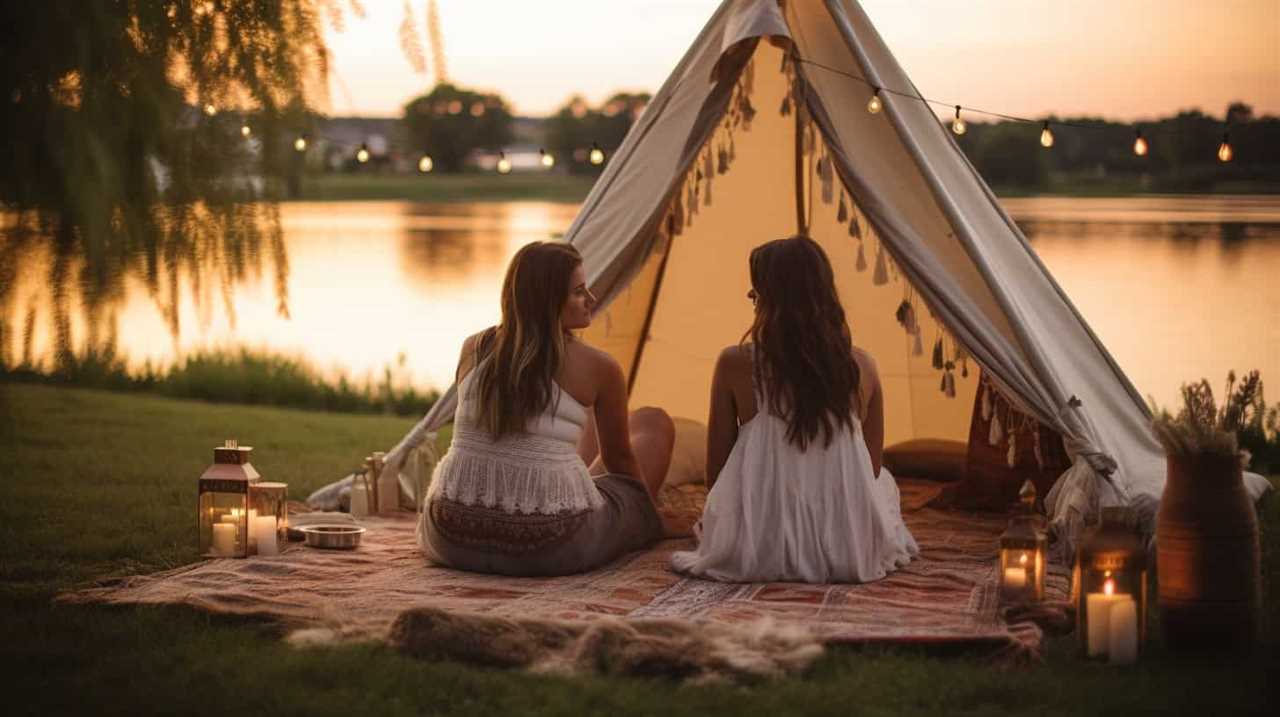
Solar Power for Glamping
We embrace renewable energy sources by utilizing solar power for glamping. Solar power efficiency is an important factor to consider when setting up a solar panel installation for your glamping site. Here are some practical tips to maximize the efficiency of your solar power system:
- Optimal Placement: Ensure that your solar panels are installed in a location that receives maximum sunlight throughout the day. This will help maximize the amount of energy generated by the panels.
- Regular Maintenance: Keep your solar panels clean and free from any obstructions, such as leaves or debris. Regularly inspect the panels for any damage and repair or replace them as needed.
- Battery Storage: Invest in a reliable battery storage system to store excess energy generated during the day. This will ensure that you have a continuous power supply, even during cloudy days or at night.
Wind Energy Options
As we explore renewable energy sources for our glamping site, wind energy offers another viable option for reducing our carbon footprint. Wind turbines, with their ability to harness the power of the wind, can generate clean and sustainable electricity. Installing wind turbines on-site can provide a significant portion of our energy needs, making our glamping experience even more eco-friendly.
To give you an idea of the potential benefits, take a look at the table below:
| Advantages of Wind Energy | Disadvantages of Wind Energy | Considerations for Wind Turbine Installation |
|---|---|---|
| – Renewable and clean energy source | – Noise and visual impact | – Proper location to maximize wind availability |
| – Reduces reliance on fossil fuels | – Potential risk to birds and wildlife | – Ensuring proper permits and regulations |
| – Low operational costs | – Initial high cost of installation | – Maintenance and monitoring of wind turbines |
By embracing wind energy infrastructure, we can take a step towards a more sustainable future for our glamping site. With the power of the wind, we can reduce our carbon footprint and provide a unique and intimate experience for our guests.
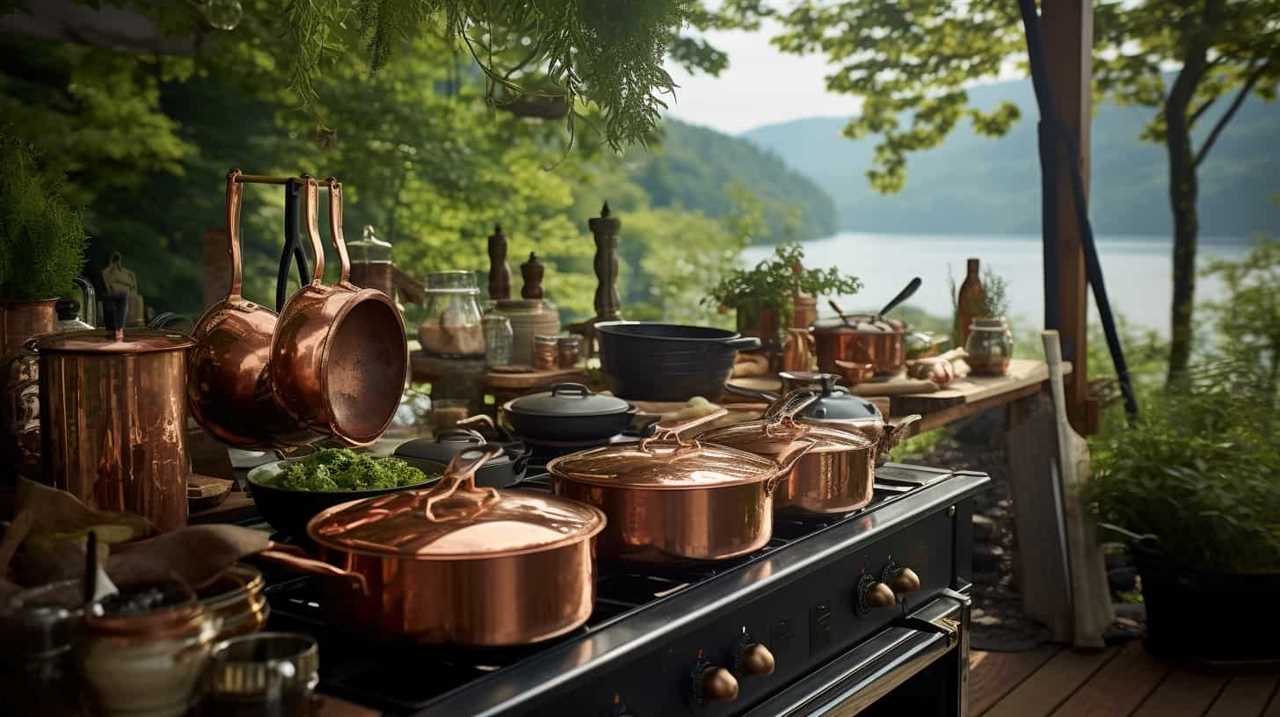
Speaking of sustainability, let’s now shift our focus to supporting local and organic food options.
Supporting Local and Organic Food Options
To ensure an eco-friendly glamping experience, we prioritize supporting local and organic food options throughout our operations. By sourcing ingredients from local farmers, we not only reduce our carbon footprint but also contribute to the sustainability of local agriculture.
Here’s how we make it happen:
- We build relationships with nearby farmers, supporting their livelihoods and promoting the local economy.
- We prioritize seasonal produce, ensuring freshness and minimizing the need for long-distance transportation.
- We strive for organic certification, guaranteeing that our food is free from harmful chemicals and pesticides.
By embracing these practices, we provide our guests with delicious, healthy meals while minimizing our impact on the environment.

Now that we’ve covered our commitment to sustainable food options, let’s explore how we can further enhance your eco-friendly glamping experience by exploring transportation options that are kind to our planet.
Exploring Eco-Friendly Transportation Options
How can we incorporate eco-friendly transportation options into our glamping experience?
One practical way is to consider eco-friendly bike rentals. Many glamping sites are located in beautiful natural surroundings, making biking a convenient and enjoyable mode of transportation. By renting bikes, we can explore the area while minimizing our carbon footprint. It allows us to connect more intimately with nature and enjoy the scenery at a leisurely pace.
Another option to consider is the availability of electric vehicle chargers. With the growing popularity of electric vehicles, many glamping sites now provide charging stations. This enables us to travel to our destination in an eco-friendly manner and recharge our vehicles while enjoying our glamping experience.
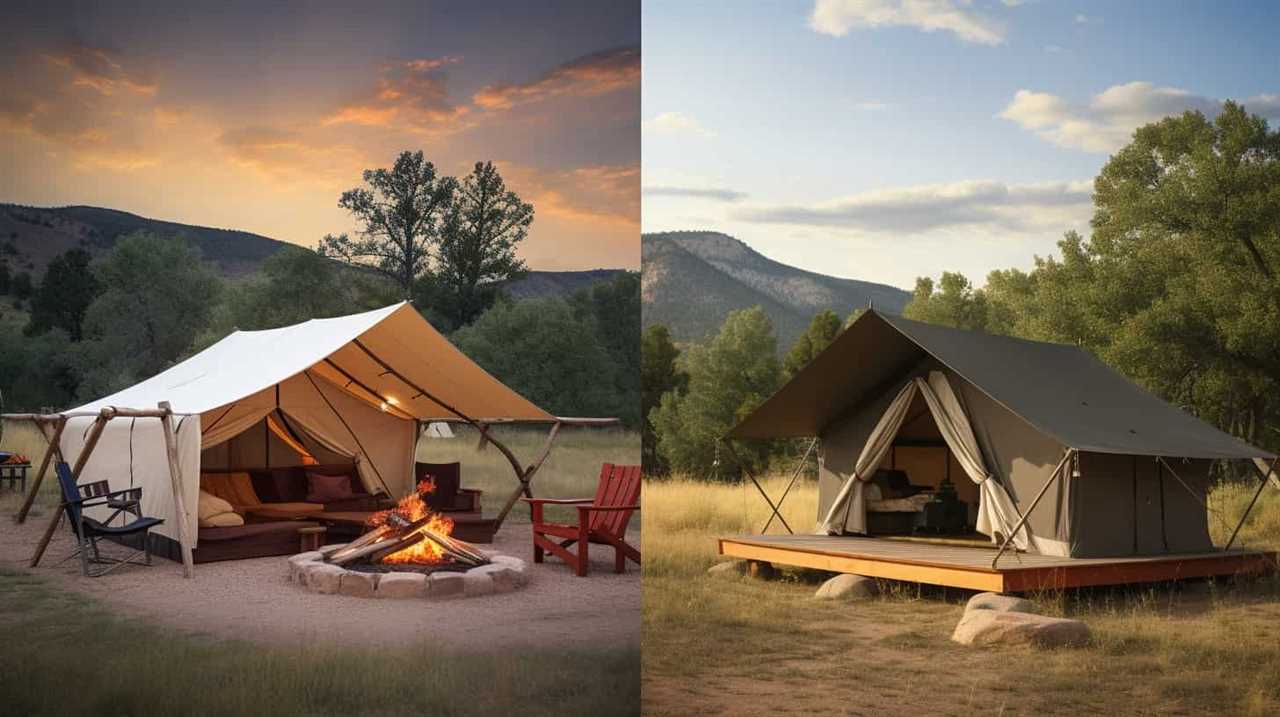
Engaging in Leave No Trace Practices
One important aspect of eco-friendly glamping is practicing Leave No Trace principles. Engaging in minimal impact, eco-sensitive practices not only ensures the preservation of the natural environment but also promotes wildlife preservation.
Here are three key ways to engage in Leave No Trace practices while glamping:
- Pack it in, pack it out: Always carry a trash bag and dispose of all waste properly, ensuring that no trace of your presence is left behind.
- Respect wildlife: Keep a safe distance from animals, refrain from feeding them, and avoid disturbing their habitats to maintain their natural behavior.
- Leave natural objects untouched: Refrain from collecting rocks, plants, or any other natural objects as souvenirs. Leave them as you found them for others to enjoy and for the ecosystem to thrive.
Emphasizing Water Conservation Techniques
Let’s continue our eco-friendly glamping journey by focusing on the importance of emphasizing water conservation techniques.
When it comes to sustainable water use, there are several water-saving techniques that can be easily incorporated into our glamping experience.
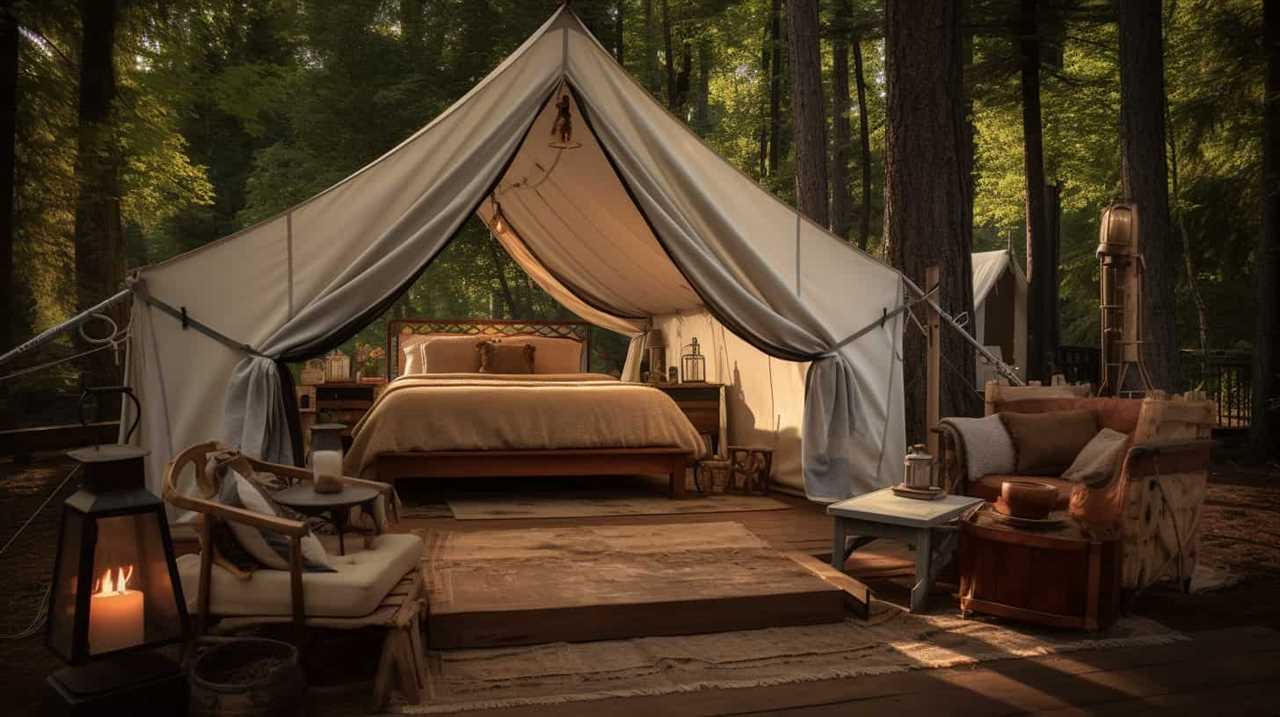
First and foremost, being mindful of our water consumption is essential. Simple actions such as turning off the tap while brushing our teeth or taking shorter showers can make a significant difference.
Additionally, opting for low-flow showerheads and faucets can help reduce water usage without compromising our comfort.
Another effective technique is collecting rainwater for non-potable purposes like watering plants or cleaning.
By implementing these water-saving techniques, we can’t only minimize our ecological impact but also ensure the availability of this precious resource for future generations.
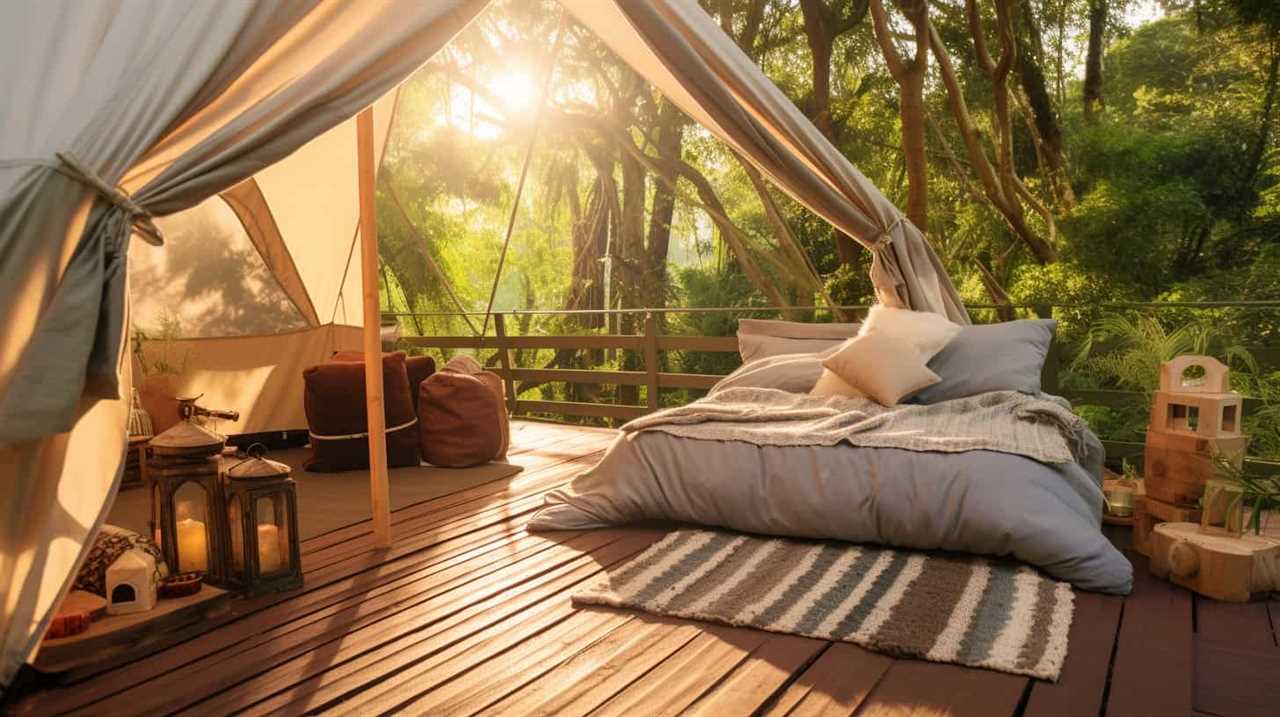
Now that we’ve covered water conservation, let’s explore how we can incorporate eco-friendly activities and excursions into our glamping experience.
Incorporating Eco-Friendly Activities and Excursions
When it comes to incorporating eco-friendly activities and excursions into our glamping experience, there are several points to consider.
First, we can seek out sustainable outdoor adventures that allow us to explore nature while minimizing our impact on the environment.
Second, conservation-focused guided tours can provide us with valuable insights into local ecosystems and wildlife conservation efforts.

Lastly, engaging in eco-conscious recreational activities such as hiking, birdwatching, or kayaking can be both enjoyable and environmentally responsible.
Sustainable Outdoor Adventures
We can enhance the eco-friendliness of our glamping experience by engaging in sustainable outdoor adventures that incorporate eco-friendly activities and excursions. Here are some practical ways to make our outdoor adventures more sustainable and enjoyable:
- Explore sustainable hiking trails: Opt for trails that are well-maintained and have a minimal impact on the environment. Look for trails that promote conservation and provide educational information about the local ecosystem.
- Use eco-friendly camping gear: Invest in camping gear made from sustainable materials such as recycled or organic fabrics. Choose gear that’s durable, lightweight, and designed to minimize waste. Consider renting or borrowing gear to reduce consumption and encourage reuse.
- Participate in eco-friendly activities and excursions: Engage in activities that promote environmental preservation, such as bird watching, nature photography, or wildlife spotting. Support local eco-tourism initiatives and businesses that prioritize sustainable practices.
Conservation-Focused Guided Tours
Continuing our exploration of sustainable outdoor adventures, we can now delve into the topic of conservation-focused guided tours that incorporate eco-friendly activities and excursions.
These tours provide an intimate and immersive experience, allowing participants to connect with nature while actively contributing to conservation efforts.
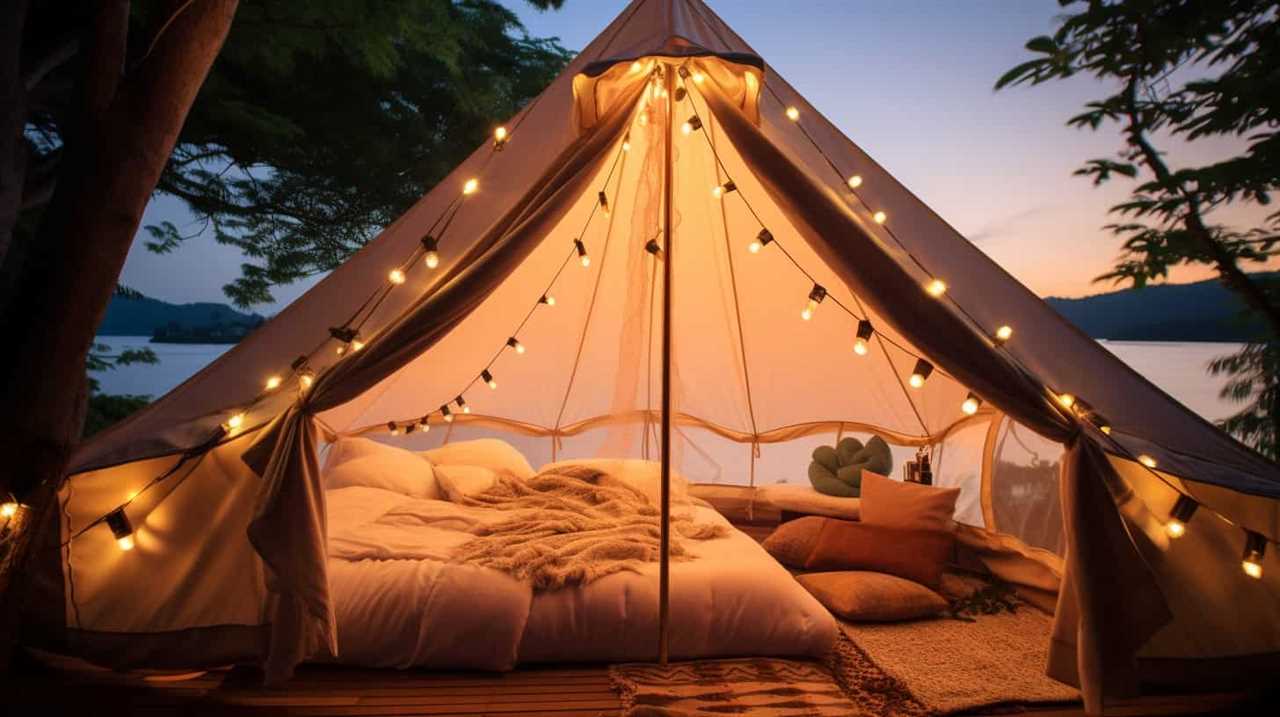
Conservation-focused hiking trips, for example, take guests through protected areas, highlighting the importance of preserving these natural habitats. Along the way, guides educate participants about local flora and fauna, emphasizing the need for conservation.
Additionally, eco-tourism initiatives are integrated into these tours, encouraging visitors to support local communities and contribute to sustainable development. Through activities such as tree planting or wildlife monitoring, guests actively contribute to the preservation of the environment.
These conservation-focused guided tours offer a unique and meaningful way to explore nature while making a positive impact on the planet.
Eco-Conscious Recreational Activities
To kick off our discussion on eco-conscious recreational activities, let’s explore a variety of engaging and sustainable excursions that promote environmentally-friendly practices.

Here are some exciting options for eco-conscious adventurers:
- Eco-conscious hiking: Lace up your boots and hit the trails with a focus on minimizing your impact on the environment. Choose trails that are well-maintained and follow Leave No Trace principles. Pack reusable water bottles and snacks in eco-friendly containers to reduce waste. Take the time to appreciate the natural beauty around you while being mindful of the fragile ecosystems you’re exploring.
- Sustainable fishing: For those who enjoy casting a line, sustainable fishing practices are essential. Opt for catch-and-release fishing to preserve fish populations and ensure their long-term survival. Use barbless hooks to minimize harm to the fish and handle them with care when releasing them back into the water. Research local fishing regulations and follow size and bag limits to protect the fishery. Remember, fishing can be a great way to connect with nature while respecting the delicate balance of aquatic ecosystems.
Frequently Asked Questions
Are There Any Specific Certifications or Standards to Look for When Choosing an Eco-Friendly Glamping Accommodation?
When choosing an eco-friendly glamping accommodation, it’s important to look for certifications and standards. These ensure that the accommodation meets sustainable practices, making your glamping experience both enjoyable and environmentally conscious.
How Can I Ensure That My Glamping Experience Is Truly Sustainable and Not Just Marketed as Such?
To ensure our sustainable glamping experience, we must go beyond the marketing facade. We can do so by researching eco-friendly accommodations that prioritize renewable energy, waste reduction, and conservation practices.
What Are Some Examples of Eco-Friendly Transportation Options That Can Be Used to Reach Glamping Sites?
When it comes to sustainable glamping accommodations, we’ve found that eco-friendly transportation options are key. By opting for electric bikes, public transportation, or carpooling, we can reduce our carbon footprint and still enjoy nature.
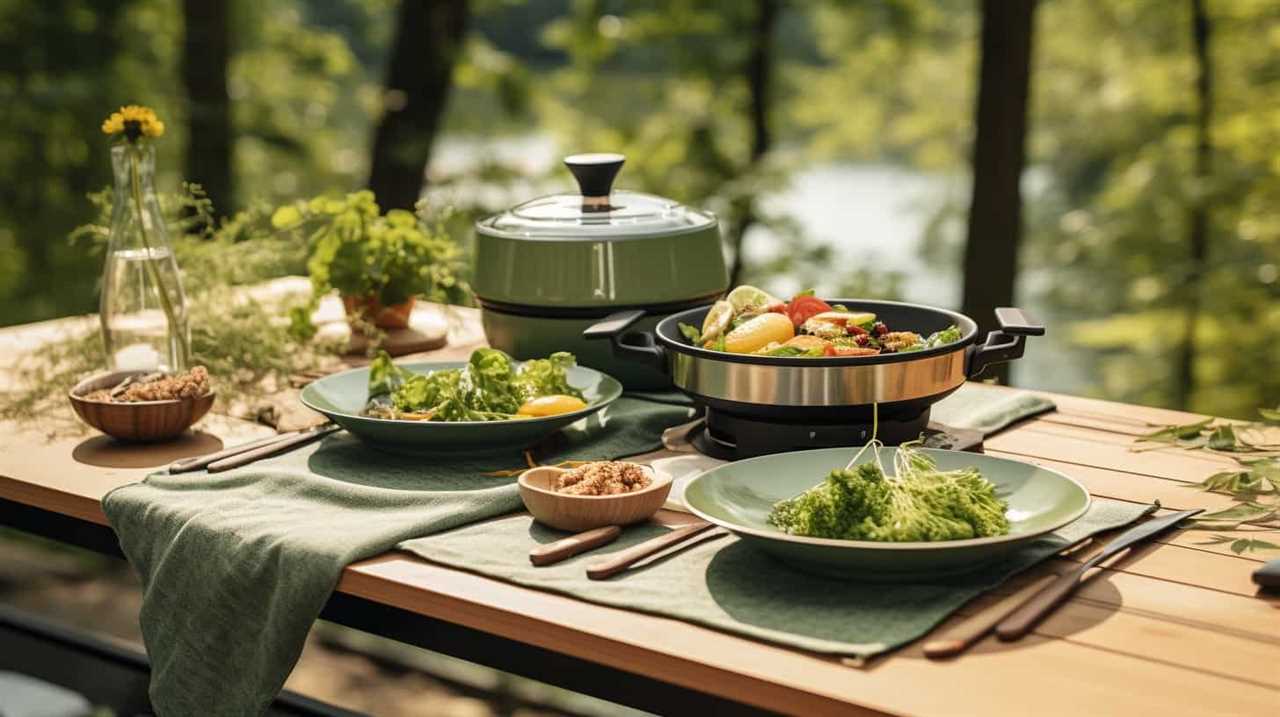
Can You Provide Some Tips on How to Engage in Leave No Trace Practices While Glamping?
When it comes to eco-friendly camping, we’ve got some tips for engaging in Leave No Trace practices while glamping. Let’s make sure we leave the environment as pristine as we found it.
Are There Any Specific Water Conservation Techniques That Are Commonly Used at Glamping Sites?
Water saving techniques at glamping sites include low flow fixtures, water-efficient appliances, and rainwater harvesting. Waste management is crucial to minimize environmental impact. Implementing these practices ensures a sustainable and eco-friendly glamping experience.
How Can I Ensure My Glamping Experience Is Eco-Friendly Using Green Equipment?
When planning your next glamping adventure, opt for ecofriendly glamping equipment to minimize your environmental impact. Look for sustainable materials like bamboo or recycled plastic for tents, solar-powered lights, and portable water filters. By choosing green equipment, you can enjoy a luxurious outdoor experience while minimizing your carbon footprint.
Conclusion
In conclusion, embracing eco-friendly practices while glamping isn’t only practical, but also essential for preserving the beauty of our natural surroundings.
By choosing accommodations that prioritize sustainability, engaging in responsible waste management, and utilizing renewable energy sources, we can reduce our environmental impact.

Additionally, supporting local and organic food options, using eco-friendly transportation, and practicing Leave No Trace principles further contribute to a sustainable glamping experience.
Did you know that glamping has been shown to reduce carbon dioxide emissions by up to 75% compared to traditional camping?










